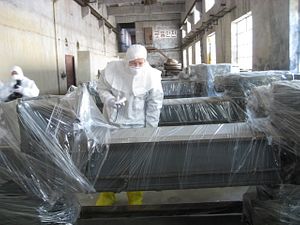Here we go again. Last Thursday, North Korean leader Kim Jong-un announced that the isolated Hermit Kingdom has developed powerful, fusion-based atomic weapons known as hydrogen bombs. The announcement came as a top United Nations human rights official told a Security Council meeting that it was “essential” that Pyongyang be referred to the International Criminal Court for its many human rights abuses.
There is little doubt that North Korea does have nukes. As The Diplomat has previously reported, Pyongyang probably has between 10 and 20 warheads, with a dozen being a good bet. However, due to Pyongyang’s technical capabilities, the most powerful of these might be in the 10 kiloton range (according to seismic tests of North Korea’s three nuclear tests, the first one in 2006 had a yield of one kiloton, the second one in 2009 clocked four kilotons, and the final test in 2013 measured seven kilotons.)
As nuclear weapons go, these are fairly non-powerful. (By comparison, the bomb dropped on Hiroshima had a yield of 15 kilotons. The largest-ever nuclear device ever exploded, the Soviet Tsar Bomba, had a yield of 50 megatons.) This would still leave a horrific casualty count, not least due to the radioactive fallout. But if the North Korean boasts about a hydrogen bomb are true, then many more could die.
What is the accuracy of Kim’s H-bomb statement? As always, any statement made by Pyongyang, especially on its nuclear capabilities, should be taken with more than a pinch of salt. North Korea has previously made unsubstantiated threats of “imminent destruction” and a “rain of fire” on South Korea, Japan, and the United States. (A personal favorite is the bizarre video showing a North Korean spaceship flying over a burning New York set to the tune of Michal Jackson’s “We Are the World.”) The South Korean government has stated that “we don’t have any information that North Korea has developed an H-bomb… and we do not believe that North Korea has the technology to produce an H-bomb,” according to DefenseNews.
Nuclear expert David Albright, head of Washington’s Institute for Science and International Security, said there have been concerns for several years that North Korea is pursuing thermonuclear weapons. However, any such device it might be working on would be cruder and more old-fashioned than the classical H-bomb and would require larger nuclear tests than North Korea has yet conducted.
Bruce Bennett at the RAND Corporation argues that Kim might have an in-between solution:
En route to the development of fusion weapons, some countries develop so-called “boosted” weapons, which use a small amount of fusion to boost the fission process, causing more large atoms to fission and thus releasing more energy — initially, perhaps a weapon of 50 kilotons or so. Because some fusion is involved in such a weapon, Kim may be claiming that he has achieved a hydrogen bomb when in practice he only has a boosted weapon.
According to Bennett, if North Korea really has a boosted nuclear weapon of perhaps 50 kilotons, it could do significant damage in a city as densely populated as Seoul. About 250,000 people could be killed in such a strike, or about 2.5 percent of the population. Further damage would be caused by the nuclear fallout. This would mark a genuine advance in the level of damage that North Korea is capable of doing. And if North Korea one day produces a true hydrogen bomb of, for example, one megaton yield, then it would be deadlier still.
Whatever the accuracy of Pyongyang’s nuclear claims, it is certain that this won’t be the last the world hears of them.

































